Dry Start of Spring in Tielt
Welcome to the March monthly overview for MeteoTielt - Weather Station Tielt.
The month of March brought a typical transition from winter to spring in Tielt. Variability was central with a mix of cold nights, mild days, and some strong wind gusts. Precipitation remained limited and the sun was regularly visible, while air quality fluctuated between clean and polluted. In this overview, we reflect on the weather patterns of last month and what this means for nature and our living environment.
Temperature Trends
March in Tielt was characterised by changeable spring weather with an average temperature of 8.5°C. The highest temperature was recorded on 8 March, with a pleasant 20.2°C, while the coldest night reached -1.2°C.
The first half of the month was rather cool and variably cloudy, with several nights below freezing. Around mid-March, it became milder, but temperatures fluctuated significantly. The warmest period occurred between 6 and 10 March, followed by a cooling down. The last days of the month were again milder with several days above 15°C.
All in all, a typical March month with spring prospects!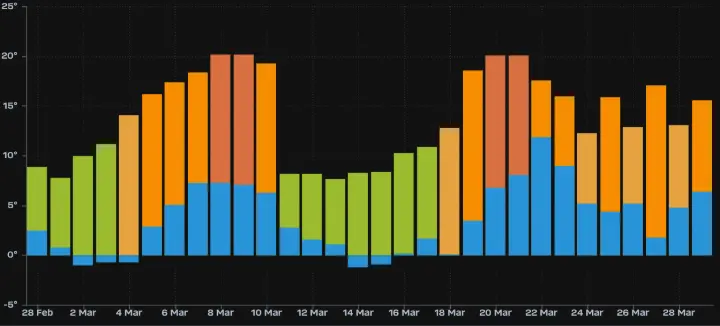
Precipitation
The precipitation graph shows that rainfall was mainly concentrated on a few separate days. The most significant rainfall occurred around 14 March, with a considerable amount of precipitation measured compared to the rest of the month. Additionally, smaller amounts of precipitation were recorded on 28 February, 2 March, 4 March, 12 March, and 28 March. The rest of the month remained almost dry.
Weather Overview
In addition to the limited precipitation, March was characterised by dry periods and a relatively stable weather pattern. There were a few changeable days, but prolonged rainfall was absent. This pattern can be attributed to a high-pressure influence, which largely kept disturbances at bay.
Consequences
The limited precipitation in March may have consequences for groundwater levels and agriculture in the region. A dry March often means that nature becomes more dependent on rainfall in April and May to build up sufficient water reserves.
Outlook
Given the dry pattern in March, it remains to be seen how precipitation will evolve in April. If this dry weather continues, early drought problems may arise. However, a wet spring could provide the necessary recovery.
March 2025 was therefore a month with only a few moments of rain, but primarily an indication that spring has started drier than average. Hopefully, April will bring a more balanced precipitation pattern for nature and agriculture in Tielt.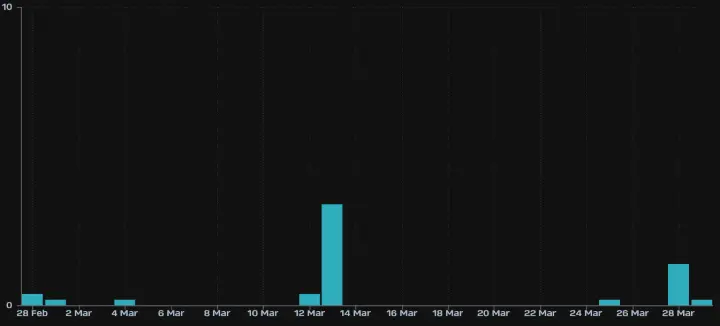
Wind:
March brought a dynamic and varied wind pattern to Tielt, with significant fluctuations in both wind speed and direction throughout the month. This overview provides a summary of the wind data, including trends and peak moments.
Wind Speed and Gusts
The average wind speed varied throughout the month, with peaks sometimes significantly above the average. The maximum recorded wind speed was 32.2 km/h, while the strongest gust reached 33.8 km/h. The highest values occurred mainly on 22 March and 28 March, where the intensity clearly increased.
In the first half of the month, there was a moderate pattern with alternating calm and windy days. From 6 March, wind speeds increased, with regular strong gusts around the middle of the month. The strongest wind speeds were recorded in the second half of March, particularly on 22 and 28 March, which stood out due to their powerful gusts.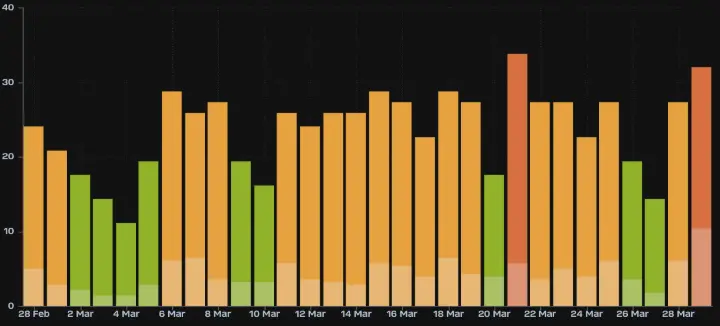
Wind directions
The wind direction was highly variable throughout the month, with prevailing winds from the southwest and northeast. During the first week of March, the winds mainly came from northeastern directions, which was accompanied by relatively dry and fresh air flows.
From the middle of the month, there was a clear shift towards south-western winds, coinciding with an increase in wind speed. On 14 and 20 March, there was a brief period when the wind temporarily blew from the southern and south-eastern directions, before shifting back to a dominant westerly direction in the last week.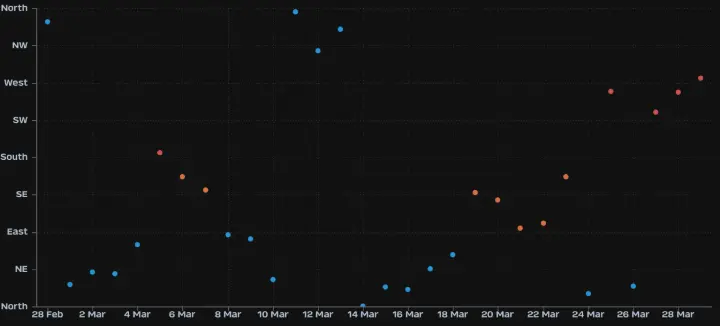
Sunshine and UV index:
Sunshine: Peaks and Troughs
The amount of sunshine varied greatly from day to day. In the first half of the month, the number of sunshine hours gradually increased, with a clear peak on14 and 15 March, when the sun shone for an extended period. After that, the duration of sunshine decreased, only to be notably high again around24 and 28 March.
Some days had significantly less sunshine, such as4 and 24 March, when the sun was only briefly visible. This pattern reflects the typical transition from winter to spring.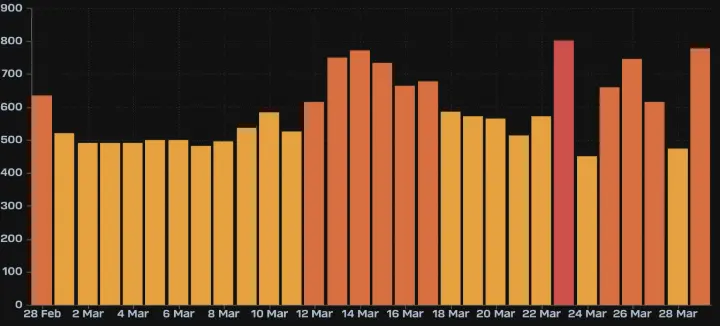
UV radiation
The UV index, which measures the intensity of solar radiation, increased throughout the month. In the first half of March, UV radiation remained relatively low, but from18 Marchit rose noticeably.
In particular, on20, 26 and 28 Marcha high UV index was recorded, indicating strong solar radiation. On these days, it was especially important to wear protection, such as sunscreen and sunglasses.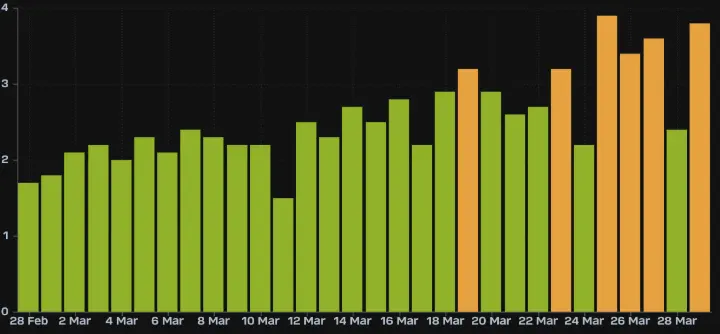
Air Quality:
March presented a varied picture of air quality in Tielt, with both peaks of pollution and periods of cleaner air. Based on the analysed data, which is visually represented in the graph above, we discuss the main trends and notable moments of the month.
Strong Peaks in Air Pollution
The first week of March experienced some of the highest levels of air pollution. Particularly on 3, 4 and 5 March, air quality was rated as poor, with concentrations well above average. This may be due to a combination of weather conditions and increased emissions from traffic and industry. A clear peak in pollution levels was also observed on 10 March and again on 25 March.
Relatively Clean Days
However, not all days were equally problematic. During the period around 13 to 15 March, the values were remarkably lower, possibly indicating better ventilation due to winds or a decrease in local emissions. Air quality levels were also better on 23 and 30 March, resulting in a more pleasant and healthier atmosphere for the residents of Tielt.
Possible Causes and Trends
The observed trends can be attributed to various factors:
- Weather influences: Wind and precipitation play a crucial role in spreading and removing pollutants from the air.
- Human activities: road traffic and industrial processes remain major sources of air pollution, particularly during weekdays.
- Seasonal effects: In March, we often see varying weather conditions that affect air quality.
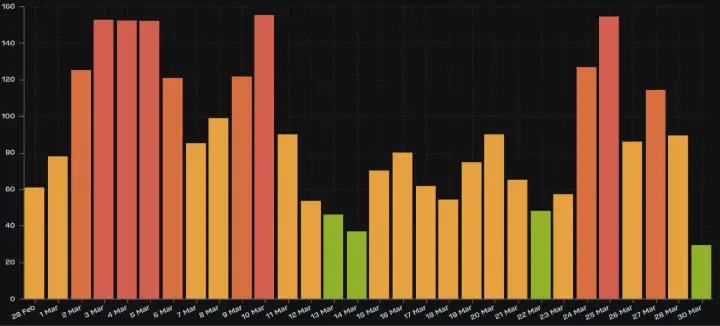
Conclusion
March was a month with typical spring characteristics: fluctuating temperatures, limited precipitation, and alternating sun and cloud. The drought may impact nature, while the rising UV radiation indicates the approaching spring. Air quality experienced varying periods, highlighting the importance of monitoring and awareness.
How did you experience the weather in March? Let us know in the comments! We are already looking forward to what April will bring.